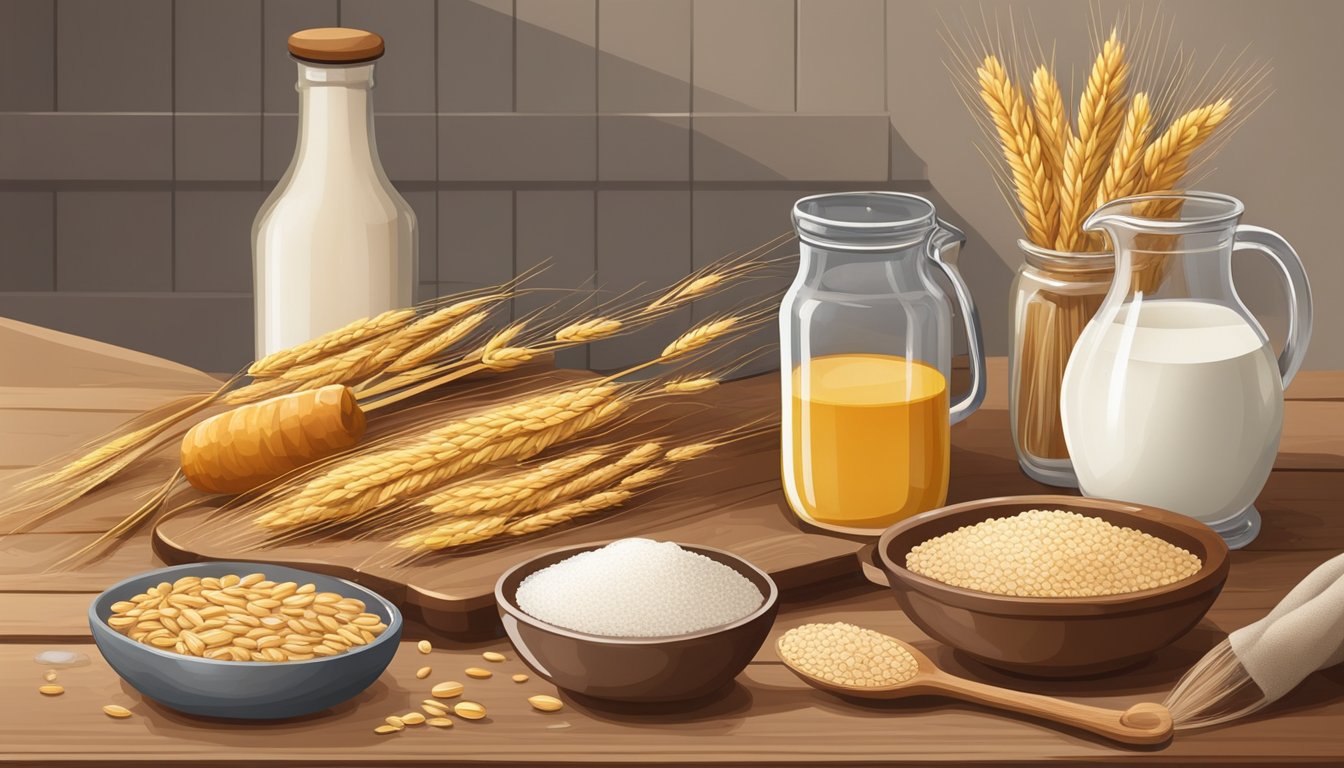Khorasan wheat, also known as kamut, is an ancient grain that has been gaining popularity among health-conscious consumers and culinary enthusiasts. This nutrient-dense whole grain offers a unique nutty flavor and chewy texture, making it an excellent choice for breakfast dishes. Khorasan wheat can be prepared in various ways, from hearty porridges to homemade breads, providing a nutritious start to the day.
Incorporating khorasan wheat into breakfast routines requires some knowledge of proper cooking techniques and flavor pairings. The grain can be soaked overnight to reduce cooking time and improve digestibility. When cooked, it can be used as a base for breakfast bowls, added to baked goods, or even ground into flour for pancakes and waffles.
Experimenting with khorasan wheat in breakfast recipes opens up a world of possibilities for those seeking to diversify their morning meals. Its versatility allows for both sweet and savory preparations, catering to a wide range of tastes and dietary preferences. By mastering the art of cooking with this ancient grain, one can create satisfying and nourishing breakfasts that fuel the body for the day ahead.
The History of Khorasan Wheat

Khorasan wheat has a rich and intriguing history spanning thousands of years. This ancient grain has experienced both obscurity and resurgence, with its journey deeply intertwined with human civilization and agricultural practices.
Origins and Legacy
Khorasan wheat originated in the Fertile Crescent, an area encompassing parts of modern-day Iraq, Syria, and Egypt. Archaeological evidence suggests its cultivation dates back to 6000 BCE. The grain earned its name from the Khorasan region in northeastern Iran, where it was widely grown.
Khorasan wheat played a significant role in ancient Egyptian agriculture. Some legends claim it was found in pharaohs’ tombs, though this remains unverified.
As a relative of durum wheat, Khorasan wheat belongs to the family of ancient grains. It remained popular in certain regions for centuries due to its nutritional value and adaptability to harsh growing conditions.
Modern Revival and Naming
Khorasan wheat faded into obscurity as modern wheat varieties gained prominence. Its revival began in the late 20th century when two farmers from Montana, Bob and Mack Quinn, obtained Khorasan wheat kernels from a friend.
The Quinns trademarked the name “KAMUT” for their Khorasan wheat in 1990. KAMUT, derived from the ancient Egyptian word for wheat, now refers specifically to organically grown Khorasan wheat meeting certain quality standards.
This revival sparked renewed interest in ancient grains. Khorasan wheat gained popularity among health-conscious consumers due to its nutritional profile and potential benefits for those with wheat sensitivities.
Today, Khorasan wheat is cultivated in various countries, including the United States, Canada, and Italy. It continues to captivate food enthusiasts and researchers alike, bridging ancient agricultural traditions with modern culinary trends.
Nutritional Profile of Khorasan Wheat
Khorasan wheat, also known as Kamut, is a nutrient-dense ancient grain packed with protein, minerals, and fiber. Its impressive nutritional profile offers numerous health benefits and makes it a valuable addition to a balanced diet.
Comparative Analysis with Other Grains
Khorasan wheat stands out among grains for its high protein content. It contains 9.8 grams of protein per cup of cooked grain, surpassing many other wheat varieties. This makes it an excellent source of plant-based protein for vegetarians and vegans.
The grain is rich in essential minerals. It provides higher levels of zinc and selenium compared to modern wheat varieties. Khorasan wheat also contains significant amounts of magnesium, important for bone health and energy production.
Fiber content in Khorasan wheat is notable, with 7.4 grams per cup. This is higher than many common grains, supporting digestive health and promoting satiety.
| Nutrient | Amount per cup (cooked) |
|---|---|
| Protein | 9.8 g |
| Fiber | 7.4 g |
| Calories | 227 |
Health Benefits Explained
The nutritional profile of Khorasan wheat contributes to various health benefits. Its high protein content supports muscle growth and repair, while also helping with weight management due to its satiating effect.
The grain’s rich mineral content plays crucial roles in the body. Zinc supports immune function, while selenium acts as an antioxidant, protecting cells from damage. Magnesium aids in energy metabolism and nervous system function.
Khorasan wheat is a good source of B vitamins, particularly niacin and thiamin. These vitamins are essential for energy production and nervous system health.
The high fiber content in Khorasan wheat promotes digestive health, helps regulate blood sugar levels, and may contribute to lower cholesterol levels. This can support heart health and reduce the risk of chronic diseases.
Selecting and Storing Khorasan Wheat

Choosing high-quality Khorasan wheat and storing it properly are crucial steps for ensuring the best flavor and nutritional value in your breakfast dishes. Proper selection and storage techniques help maintain the integrity of this ancient grain.
Identifying Quality Khorasan Wheat
When selecting Khorasan wheat, look for plump, uniformly sized wheat berries with a golden-amber color. The grains should have a slight sheen and feel heavy for their size. Avoid any berries that appear discolored, shriveled, or have visible signs of damage.
Opt for organic, non-GMO Khorasan wheat whenever possible. This ensures the wheat is free from pesticides and genetic modifications. Check the packaging for certifications or labels indicating these qualities.
For the freshest flavor, consider purchasing whole wheat berries and milling them into flour at home. This preserves the nutrients and natural oils in the grain until you’re ready to use them.
Best Storage Practices
Store Khorasan wheat berries in an airtight container in a cool, dry place. A pantry or cupboard away from direct sunlight is ideal. Properly stored, whole wheat berries can last up to a year.
For longer-term storage, keep the container in the refrigerator or freezer. This extends the shelf life to 18 months or more. Before using refrigerated or frozen wheat berries, allow them to come to room temperature to prevent condensation.
If you’ve milled your own flour, store it in an airtight container in the refrigerator. Fresh milled flour is best used within 1-2 weeks for optimal flavor and nutrient content.
Regularly check stored Khorasan wheat for signs of spoilage, such as off odors or the presence of insects. Proper storage helps maintain the grain’s nutritional value and prevents rancidity.
Prepping and Cooking Basics
Khorasan wheat requires proper preparation and cooking techniques to unlock its full potential. Mastering these fundamentals ensures optimal texture, flavor, and nutritional benefits.
Preparing Khorasan Wheat for Cooking
Soaking is essential for Khorasan wheat. Rinse 1 cup of wheat berries under cold water, then place in a bowl and cover with fresh water. Allow to soak for 6-8 hours or overnight. This process softens the grains and improves digestibility.
For sprouted Kamut, extend the soaking time to 12 hours. Drain and rinse the berries, then place them in a strainer covered with a kitchen towel. Wait for small sprouts to appear, usually within 1-2 days.
Drain and rinse the soaked or sprouted wheat before cooking. This step removes any residual debris and prepares the grains for the cooking process.
Cooking Methods and Techniques
Stovetop: Combine 1 part prepared wheat with 3 parts water or broth. Bring to a boil, reduce heat, and simmer for 40-60 minutes until tender.
Instant Pot: Use a 1:2 ratio of wheat to liquid. Cook on high pressure for 20 minutes, then allow natural release for 10 minutes.
For breakfast porridge, cook Khorasan wheat using the stovetop method. Add milk, cinnamon, and sweetener of choice during the last 5 minutes of cooking.
Baking: Incorporate cooked Khorasan wheat into bread doughs or use Khorasan flour for hearty baked goods. Optimal oven temperatures range from 350°F to 375°F (177°C to 190°C).
Kamut for Breakfast: Recipe Ideas
Kamut, also known as Khorasan wheat, offers a nutritious and versatile base for various breakfast dishes. Its nutty flavor and hearty texture make it an excellent choice for both sweet and savory morning meals.
Wholesome Pancakes and Waffles
Kamut flour can elevate traditional pancakes and waffles with its rich, buttery taste. Mix 1 cup of kamut flour with 1 teaspoon of baking powder, a pinch of salt, and 1 tablespoon of sugar. Add 1 cup of milk, 1 egg, and 2 tablespoons of melted butter.
For pancakes, cook the batter on a griddle until golden brown. Waffles require a waffle iron and slightly more oil in the batter for crispiness.
Top these breakfast classics with fresh berries, a drizzle of maple syrup, or a dollop of Greek yogurt for added protein.
Savory Breakfast Bowls and Cereals
Kamut berries make an excellent base for hot breakfast cereals. Simmer 1 cup of kamut berries in 3 cups of water for about 40 minutes until tender. Add a pinch of salt and your choice of milk.
For a savory twist, prepare kamut like oatmeal and top with:
- Soft-boiled egg
- Sautéed spinach
- Crumbled feta cheese
- Sliced avocado
This nutrient-dense bowl provides a balanced start to the day with complex carbohydrates, healthy fats, and protein.
Innovative Grain Bowl Creations
Kamut’s chewy texture works well in cold breakfast bowls too. Cook kamut berries in advance and store in the refrigerator for quick morning prep.
Create a refreshing bowl by combining chilled kamut with:
- Greek yogurt or kefir
- Sliced almonds or walnuts
- Fresh fruit like peaches or apples
- A sprinkle of cinnamon
For a more indulgent option, try a kamut-based “breakfast risotto” by cooking the grain in milk and adding vanilla, honey, and dried fruits. This creamy, comforting dish offers a unique twist on traditional breakfast cereals.
Baking with Kamut Flour
Kamut flour, derived from Khorasan wheat, offers unique flavor and nutritional benefits in baking. Its versatility shines in both savory and sweet applications.
Kamut-Based Bread Varieties
Kamut flour produces exceptional bread with a rich, buttery taste. For a basic Kamut bread, combine 3 cups of Kamut flour, 1 teaspoon of salt, 1 tablespoon of active dry yeast, and 1 1/4 cups of warm water. Mix thoroughly and knead for 10 minutes.
Let the dough rise for 1-2 hours. Shape into a loaf and bake at 350°F (177°C) for 30-35 minutes.
For a heartier option, incorporate seeds or nuts into the dough. Kamut sourdough is another popular choice. To create a Kamut sourdough starter, mix equal parts Kamut flour and water daily for 5-7 days until bubbly and active.
Sweet Treats and Desserts
Kamut flour adds depth to sweet baked goods. For Kamut chocolate chip cookies, use 2 cups Kamut flour, 1/2 cup butter, 1/2 cup sugar, 1 egg, and 1 cup chocolate chips. Mix wet and dry ingredients separately, then combine and bake at 350°F (177°C) for 10-12 minutes.
Kamut pancakes offer a nutritious breakfast option. Blend 1 cup Kamut flour, 1 cup milk, 1 egg, and 1 tablespoon baking powder. Cook on a griddle until golden brown.
For a rustic Kamut cake, mix 2 cups Kamut flour, 1 cup sugar, 2 eggs, 1/2 cup oil, and 1 teaspoon vanilla. Bake at 350°F (177°C) for 25-30 minutes.
Accompanying Flavors and Pairings

Khorasan wheat’s nutty flavor pairs well with various sweeteners and dairy alternatives. These complementary ingredients enhance the grain’s natural taste while providing additional nutritional benefits.
Natural Sweeteners and Kamut
Honey adds a floral sweetness that complements Kamut’s nutty notes. Drizzle a small amount over cooked Khorasan wheat berries for a balanced breakfast. Maple syrup offers a rich, caramel-like flavor that enhances the grain’s hearty texture. Use it sparingly to avoid overpowering the wheat’s subtle taste.
Coconut sugar provides a lower glycemic alternative with a slight caramel undertone. Sprinkle it lightly on Kamut porridge for a gentle sweetness. These natural sweeteners not only improve flavor but also contribute trace minerals and antioxidants to the meal.
Dairy Alternatives for Kamut Dishes
Almond milk pairs excellently with Khorasan wheat, offering a creamy texture and nutty flavor that complements the grain. Use unsweetened almond milk to control sugar intake and allow the wheat’s natural taste to shine. It adds calcium and vitamin E to Kamut-based breakfasts.
Oat milk provides a neutral, slightly sweet backdrop that doesn’t overpower Khorasan’s flavor. Its creamy consistency works well in Kamut porridge or as a base for overnight oats. Coconut milk imparts a tropical twist, enhancing the grain’s nuttiness with its rich, buttery texture.
Understanding Gluten in Kamut

Kamut, also known as Khorasan wheat, contains gluten and has unique properties compared to modern wheat varieties. Its gluten content affects its suitability for different dietary needs and cooking applications.
Is Kamut Gluten-Free?
Kamut is not gluten-free. As an ancient wheat variety, it contains gluten proteins. In fact, Kamut has approximately three times more gluten than some other ancient grains.
This high gluten content contributes to Kamut’s excellent baking properties. It provides structure and elasticity to bread and other baked goods.
People with celiac disease or non-celiac gluten sensitivity should avoid Kamut. Its gluten levels make it unsuitable for gluten-free diets.
Consumption Advice for Gluten Sensitivities
While Kamut is not safe for those with celiac disease, some individuals with mild gluten sensitivities may tolerate it better than modern wheat. This potential tolerance is due to Kamut’s different protein structure.
However, it’s crucial to consult a healthcare professional before introducing Kamut into a gluten-sensitive diet. Each person’s tolerance levels can vary significantly.
For those without gluten sensitivities, Kamut offers nutritional benefits. It’s rich in protein, fiber, and various minerals. Incorporating Kamut into a balanced diet can add variety and nutritional value to meals.
Tips and Tricks for Mastering Khorasan Wheat
Mastering Khorasan wheat requires attention to detail and strategic preparation. The following tips focus on enhancing texture and flavor while creating nutritious breakfast options.
Enhancing Texture and Flavor
To maximize the nutty flavor of Khorasan wheat, toast the grains before cooking. This simple step intensifies their natural taste. When baking with Khorasan flour, adjust liquid ratios slightly as it absorbs more moisture than regular wheat flour.
For a softer texture in baked goods, combine Khorasan flour with all-purpose flour in a 1:1 ratio. This maintains the nutritional benefits while improving texture. Adding a tablespoon of baking powder per cup of Khorasan flour helps achieve a lighter crumb in quick breads and muffins.
Melted butter or dairy-free alternatives enhance the rich flavor of Khorasan wheat. Use 1/4 cup per 2 cups of flour in recipes for optimal taste and moisture.
Creating a Balanced Breakfast
Khorasan wheat’s high protein content makes it an excellent base for nutritious breakfasts. Cook Khorasan berries in advance and store them in the refrigerator for quick morning meals.
Combine cooked Khorasan berries with Greek yogurt, fresh fruits, and a drizzle of honey for a protein-packed breakfast bowl. For a savory option, mix cooked berries with sautéed vegetables and a poached egg.
Khorasan flour works well in pancake and waffle batters. Replace 25-50% of regular flour with Khorasan flour for added nutrition and flavor. Serve with fresh berries and pure maple syrup for a balanced start to the day.
Create a breakfast porridge by simmering Khorasan berries with milk or plant-based alternatives. Top with nuts, seeds, and dried fruits for extra nutrients and texture.




